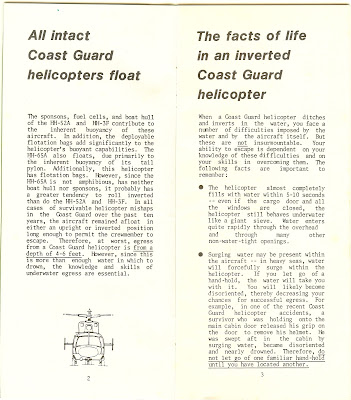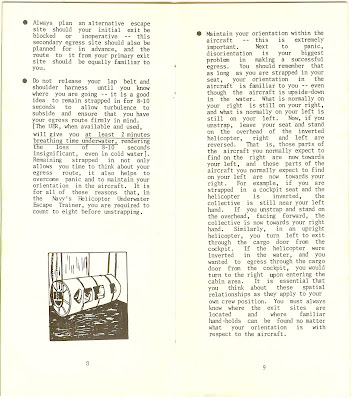I found the original 9D5 Dunker training pamphlet that was handed out to everyone in my Aviation Machinists Mate, Class "A" School class, back in 1986! This was during my time at US Coast Guard Aviation Training Center Elizabeth City, NC. (between USCG Station Grays Harbor and USCG Air Station Borinquen).
 |
| A photo of myself at USCG Air Station Borinquen, 1986 |
All US Coast Guard aviators must complete the 9D5 Dunker training in order to fly on any Coast aircraft as a pilot or air crewman. The first time you "ride the Dunker" is during flight school, or "A" school. After that there is a re-certification that occurs (or did occur) every 3 years for the guys who continued flying on helicopters. Since I was in "A" school, this was my first time through the training. If you didn't pass all the Dunker rides, you were out of the school and headed back to a ship!
As a side note, I believe that all of the old 9D5 Dunkers have been retired, sometime around 2008, and replaced with a newer model. You still have to ride a dunker, but the new one's look way nicer than the "metal barrel" we rode back in the 1980's!
At the time I was in the Coast Guard, the 9D5 Dunker was located at Aviation Survival Training Center (ASTC), Norfolk, Virginia, and was run by the US Navy. When the appointed day arrived, we all loaded up and headed to Norfolk. It was a full day of survival swim training (in full flight gear), and 5 rides on the 9D5, also in full flight gear.
Full flight gear means, flight suit, flight boots, gloves, flight helmet, and survival vest with weights in the pockets.............for the first ride that is. After your first ride, then you got the black hood over your head, in addition to all your flight gear. That way you would have zero visibility for the next four rides. Sound like fun? No? Well there is more to it than that.
Basically the Dunker is a big barrel shaped, mock helicopter, equipped with a cockpit and crew seating in the cargo area. All the windows have welded steel mesh over them, with the exception of the cockpit side windows and the cargo side door. It is equipped with seats that have standard 5-point harnesses, just like the ones in use on the helicopters.
The Dunker is suspended about 20 feet above a deep pool, with cables. After a full crew is loaded up and strapped in, (two in the cockpit, and four in the crew area), it is dropped into the water. As soon as it hits, it starts to roll over and sink. This is when it get "real"!
Depending on what side you are on, you either immediately go under water, or have time to think about it as you roll over and then submerge.
After grabbing a short breath, you hang out in your seat, strapped in, and upside down, until the water stops surging. Then everyone releases and egresses from the upside down and submerged "helo". Everyone makes their way to the side cargo door, hand over hand, and then out the door, in an orderly manner. After you are out, it's up to the surface, and that welcome breathe of fresh air. Oh yes, did I say that 4 of the 5 rides you are wearing a hood over your head? That is the panic, disorientation, "I feel like I'm about to drown", water rammed up your nose and into your sinuses, part of the "ride".
Basically you have to control the panic urges, and trust me, it feels like you are right on the edge. For anyone who "freaks out" and panics, there are US Navy Divers in place to drag your water-logged butt out, so you can try that ride again! Trust me, you do not want to "freak out", and give those divers a reason to do their job. If you release your harness too early, then you get sucked back to the end of the Dunker where you are pressed against the end steel mesh by the surging water, until you drown, or until a Navy Diver saves you........... just a little added incentive to not screw things up!
Passing the Dunker is one of those very significant milestones you pass on the way to your Naval Aviator or Air Crewman Wings (pilot or crewman). For those who don't, or can't, pass the Dunker, it's the walk of shame, and back to a cutter you go. We actually lost a couple of guys from our class because they couldn't complete the rides. It was sad to see them go.
For those of us who went on to fly on helicopters, we could look forward to more yearly "Dunker-style" training at our air stations to qualify to use the Underwater Escape Re-Breather vests that we all wore.
Before we take a look at the entire pamphlet, you can take a look at my earlier posts about my time at USCG Air Station Borinquen, Puerto Rico, and the gear I wore:
https://sharky-fourbees.blogspot.com/2011/03/united-states-coast-guard-flight-helmet.html
https://sharky-fourbees.blogspot.com/2011/03/united-states-coast-guard-flight-gear.html
https://sharky-fourbees.blogspot.com/2010/12/uscg-aircrew-survival-knife.html
Here is the entire pamphlet. For those of you who "rode the 9D5 Dunker", back in the day, it'll bring back a few memories. For the rest of you, here's a glimpse at what it takes to get your wings. You can click on any of the photos to get a larger, full screen view. Enjoy!
















No comments:
Post a Comment